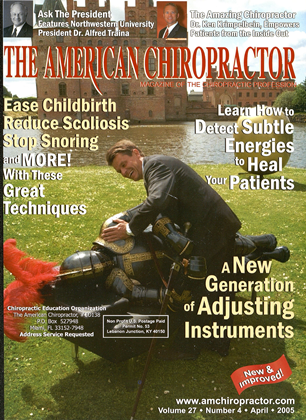Patient Age: 50 Gender: Female Occupation: Bookkeeper Primary subjective patient complaint Weight gain that the patient cannot lose despite repeated attempts at dieting and exercise. Characteristics of symptoms The patient's weight is currently 205 pounds. The last time she really felt good was at age 28, at which time she went through kidnapping and sexual abuse. She began putting on weight at that time and has since been through counseling, but unable to lose the weight. In addition, she has been dealing with some dizziness, vertigo problems and digestive problems. The patient's weight gain was suggestive of switched metabolism, which would tend to implicate the triple heater channel in terms of its relationship to metabolism. Objective findings The patient has significant spinal fixations affecting the lumbosacral, mid thoracic, and CT (cervical/thoracic) area with anterior cervical fixations bilaterally. Temporo-Mandibular Joint (TMJ) dysfunction present along with active trigger points in the SCM (sternocleido-mastoideus) and scalene muscles, reproducing her dizziness symptoms. Moderate tenderness in the digestive area present, along with blood profile results demonstrating adrenal exhaustion, toxic acidosis, major blood sugar disregulation problems and insulin resistance. There are elevated cardiovascular risk markers along with anemia. In addition, the patient has major inflammatory imbalance, and impaired me-thylation. Her vitality and longevity assessment or bioimpcdance study showed a body fat percent of 49%. Her initial EMI (Electro Meridian Imaging) showed significant depression of the small intestine, triple heater, and large intestine channels corresponding with her digestive and metabolic dysfunction. She had a borderline split affecting the lung and pericardium channels. Working diagnosis Obesity, secondary to switched metabolism, triggered by food allergies, bio- chemical imbalances and bioelectric imbalances in her acupuncture system. Maldigestion, malabsorption, secondary to food allergies and bioelectric imbalance and fatigue, secondary to the same factors above. Note: The actual point selection and treatment protocol changes visit-to-visit, with Electro Meridian Imaging™ being performed (done) approximately every three to four visits (most of the time). TREATMENT Points treated with each EMI and each visit, but included initially, SP-4, PC-6, along with LU-7, SP-4, SP-6 bilaterally, ST-6 bilaterally, CV-6, C V-12, ST-25, and auriculotherapy points as indicated for the involved organ systems. In addition, SI-3, TH-3, and LI-11 were treated, as well as SP-5 bilaterally. The associated points were treated on each visit with teishein. Spinal manipulative therapy along with extremity joint manipulation, mobilization, and myofascial trigger point release through the TMJ area was used. The patient was treated over 14 visits with her most recent progress update of Aug. 5, 2004, showing an overall high level of satisfaction and improvement through her program. She had a bit of a downturn on her next progress update of Sept. 20,2004, secondary to the patient being away on a trip and going off her diet and having a bit of a setback. The patient has lost approximately 50 pounds through the process with nice improvement in her digestive function and has been free of the dizziness and vertigo through her treatment plan. Overall, she is quite pleased and represents another case study that shows the effectiveness of an integrated care approach utilizing chiropractic, acupuncture, and lifestyle medicine.! More case studies at: ( www.amchiropractor.com)xa A IV6V graduate of Cleveland Chiropractic College. John A. Amaru. DC. HIAMA. is the founder and director of the International Academy of Mctliccil Acupuncture, lie can be reached at 1-800-327-1113.
 View Full Issue
View Full Issue






